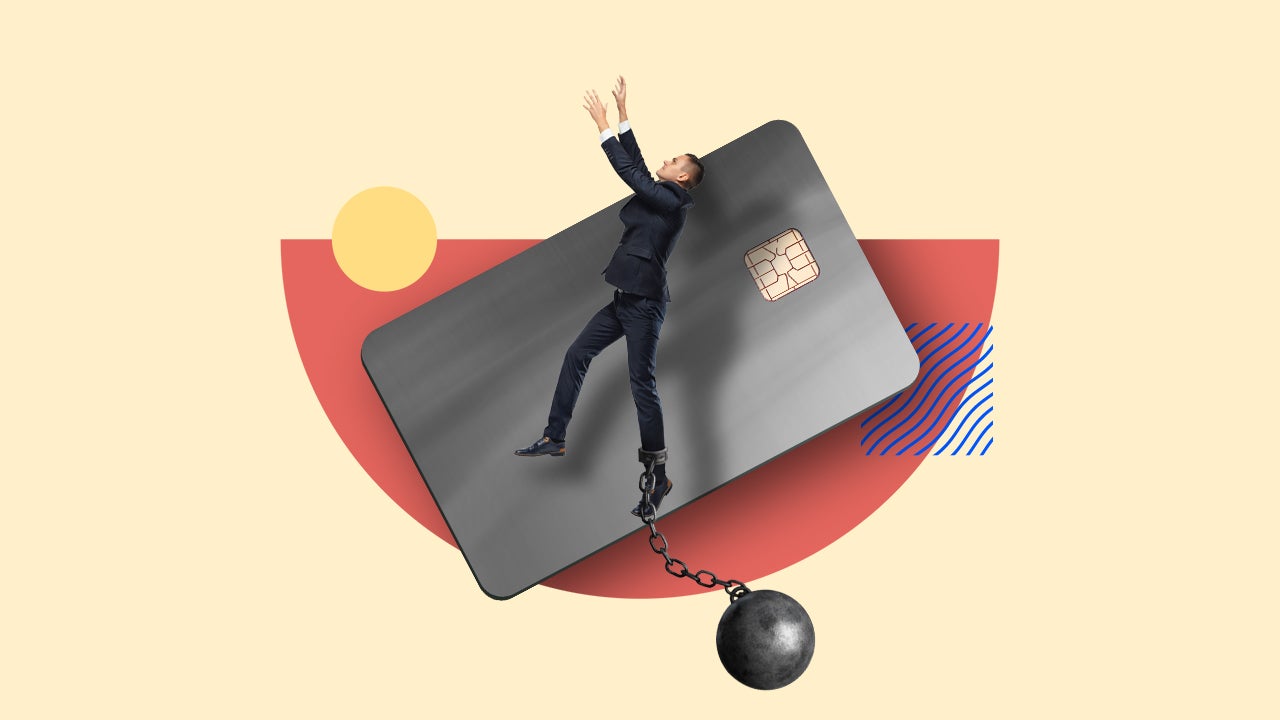Bankrate’s 2025 Credit Card Debt Report

Here’s the kicker about credit card debt — as soon as it starts rolling down the hill, it gains momentum and size, thanks to interest. Unfortunately, it’s a slippery slope that many credit cardholders are on.
Credit card interest rates are some of the highest borrowing costs out there, currently averaging above 20 percent. When you carry a card balance, not only are you taking money from your future self, but you’re piling interest on top of interest.
The implications of credit card debt are far-reaching, from pausing major life decisions to feeling like you’ll never pay it off. But with the right tools, it’s possible to tackle your debt before it takes over.
For millions of American households, credit card debt represents their highest-cost debt by a wide margin— Ted Rossman, Bankrate Senior Industry Analyst
Bankrate’s key insights on credit card debt
46% of credit cardholders report having a credit card balance. About a quarter (23%) don’t think they’ll ever pay it off.
Source: Bankrate’s 2025 Credit Card Debt Survey
Among credit card debtors, 45% say their debt comes from emergency/unexpected expense(s), including car repairs (11%), medical bills (10%), home repairs (8%) and other emergency or unexpected expenses (16%). Twenty-eight percent cite day-to-day expenses such as groceries, childcare and utilities.
Source: Bankrate’s 2025 Credit Card Debt Survey
64% of credit card debtors, defined as credit cardholders who carry a balance month to month, have delayed or avoided other financial decisions because of their credit card debt.
Source: Bankrate’s 2025 Dealing With Debt Survey

Bankrate Data Center
Since 1976, Bankrate has been the go-to source for personal finance data, publishing average rates on the most popular financial products and tracking the experience of consumers nationwide.
See moreNearly half of American credit cardholders still carry debt, mainly due to emergency costs
Lana Linge, 29 years old, has been through three cycles of credit card debt during the last decade. Most recently, she was in $40,000 of credit card debt spread across six cards.
Linge admits, in some ways, she was living beyond her means and spending to cope emotionally. But she was also laid off the year prior, and was still on the hook for mortgage payments, an emergency vet bill and everyday expenses like gas and groceries.
Inflation had increased… and everything cost more. I didn’t adjust my cost of living or lifestyle at all.— Lana Linge, Host of Your Inner Spark Podcast
Linge is not alone — 46 percent of American credit cardholders carry a balance as of June 2025. That’s down slightly from 48 percent in November and 50 percent in June 2024, but still up from 39 percent in December 2021.
Linge never missed a credit card minimum payment. But eventually, she could no longer pay her bills. She cut up her credit cards and made the decision to file for Chapter 7 bankruptcy.
“When you view yourself as a pretty responsible individual, it can be very difficult to determine the fact that you have a part of your life that you have not been responsible in,” Linge says. She also shares that she grew up in a financially unstable household. At one point, they lost their home to foreclosure.
Moving forward, Linge says she aspires to not end up in this situation again — by checking her finances daily and changing her mindset around money.
Americans have trouble talking or even thinking about credit card debt. We need to take the stigma out of it. If you have credit card debt, you have plenty of company, and the causes are usually practical. But you can’t hide from it, especially since credit card balances and rates are near record highs.
— Ted Rossman Bankrate Senior Industry Analyst
Fewer Americans carry credit card debt, but Gen Xers and millennials lead the pack
The number of American cardholders with credit card debt — 46 percent — has dropped four percentage points since this time last year.
Even so, more than half of Gen Xers (ages 45-60; 55 percent), about half of millennials (ages 29-44; 49 percent), more than 2 in 5 boomers (ages 61-79; 44 percent) and more than 1 in 3 Gen Zers (ages 18-28; 35 percent) with credit cards carry a balance from month to month.
Some credit card debtors feel doomed
Almost a quarter (23 percent) of credit card debtors don’t believe they’ll ever get out of credit card debt. And this isn’t confined to older generations. Twenty-one percent of millennials and 17 percent of Gen Zers with credit card debt believe they will always have credit card debt, compared with 25 percent of Gen Xers and 26 percent of boomers.
Fewer than half of debtors (48 percent) have a plan to pay off their credit card debt.
More than a quarter of debtors (27 percent) feel less confident in their ability to get out of credit card debt now than they did last year.
And almost 1 in 5 debtors fear tariffs will add to their debt (19 percent) and/or worry they might not be able to make their minimum payments at some point in the next six months (18 percent).
“The fact that most credit card debtors don’t have a plan to get out of debt is alarming but not surprising,” Rossman says.
In general, money is a common stressor for Americans’ mental health, with 43 percent citing it as something which has a negative impact on their mental health, according to Bankrate’s 2025 Money and Mental Health Survey. Current events follow closely at 38 percent. So today’s economic indicators might explain why Americans are hemming and hawing about their future debt repayment.
More debtors carry a balance for at least a year
In November 2024, around half of credit card debtors (53 percent) had carried a balance for at least a year. Now, it’s up to 3 in 5 (60 percent). Another roughly 1 in 5 debtors (19 percent) have carried a balance for at least five years.
Even if you’re making minimum payments on your balance, that may not cut it.
“Minimum payments could keep you in debt for decades and cost you thousands of dollars in interest,” Rossman explains.
For example, the average credit card balance is $6,371, according to TransUnion. If you only make minimum payments, you could be in debt for 217 months and pay $9,254 in interest based on the average interest rate in mid-June of 20.12 percent.
Emergency and day-to-day expenses are the most common reasons for credit card debt
Among credit card debtors, nearly half (45 percent) say the primary cause was an emergency expense.
That includes car repairs (11 percent), medical bills (10 percent), home repairs (8 percent) and other emergency or unexpected expenses (16 percent).
More than a quarter (28 percent) cited day-to-day expenses such as groceries, childcare and utilities as the primary cause. Only 11 percent cited retail purchases such as clothing and electronics as the cause of their debt, and only 9 percent blamed vacation/entertainment expenses. Seven percent point to something else.
Credit card debt puts people’s lives on pause
Nearly 2 in 3 U.S. credit cardholders with debt (64 percent) say they have delayed or avoided financial decisions because of their credit card debt, according to Bankrate’s 2025 Dealing With Debt Survey.
Saving for an emergency (34 percent), investing (23 percent) and buying a vehicle (21 percent) are the most likely to be set back.
Credit card debtors also say they’ve put off helping family and/or friends (19 percent), donating to charity (17 percent), spending on wellness (17 percent, e.g., gym fees, weight management programs, meal delivery services), spending on healthcare (17 percent, e.g., medical procedures, medication) and making home purchases (13 percent).
And when it comes to major life choices, debtors have delayed continuing education and/or job-related training courses (8 percent), different and/or new employment (7 percent), having children (5 percent) and getting married (5 percent).
Missing these milestones shows that credit card debt can hold you back. “This is why it’s so important to pay off your credit card debt as quickly and cost-effectively as possible,” Rossman says.
Most credit card debtors admit that debt impacts their financial choices
Among credit card debtors, more than 4 in 5 (84 percent) say their credit card debt impacts their financial choices — such as whether to make a big purchase, take a vacation or look for a new job.
That includes 29 percent who report their choices as being significantly impacted, 31 percent moderately impacted and 24 percent slightly impacted. Only 12 percent said their debt has no impact, and 4 percent didn’t know.
4 steps to take toward paying off credit card debt in 2025
Here are a few stepping stones toward managing your credit card debt this year. The sooner you can get ahead of your debt, the less you’ll have to fork over in interest fees.
The bottom line
With so many credit cardholders in debt, it’s clear that Americans face tough financial circumstances. But it’s imperative to have a plan for debt payoff before interest gets out of control. Debtors might consider signing up for a balance transfer card, working with a reputable nonprofit credit counselor and adjusting their income and expenses to leave room for repayment.
“None of this needs to last forever, but buckling down for a period of time and knocking out your credit card debt can do wonders for your overall financial situation,” Rossman says.
Why we ask for feedback Your feedback helps us improve our content and services. It takes less than a minute to complete.
Your responses are anonymous and will only be used for improving our website.






